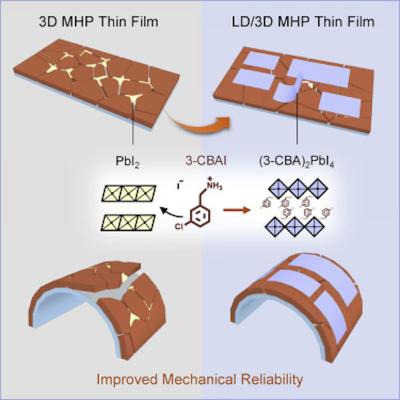An international team of researchers, including ones from Brown University, EPFL, Dalian University of Technology and Shaanxi Normal University, has developed a flexible thin-film perovskite solar cell with an efficiency of 21.0%.
The perovskite layer for the cell, which has an “n-i-p†layout, was fabricated using a metal-halide capping layer placed on top of a three-dimensional metal-halide perovskite film. This design reportedly provides hermetically sealed encapsulation, which is traditionally difficult to achieve in flexible perovskite cells, and also enhances the photocarrier properties at the interface between the perovskite film and the hole transport layer (HTL).
The MHP precursor was deposited through spin-coating on substrates made of fluorinated tin-oxide (FTO) and glass, followed by thermal annealing at 100 C. The perovskite layer was then sandwiched between a tin(IV) oxide (SnO2) electron transport layer (ETL) and an HTL made of Spiro-OMeTAD. Indium tin oxide (ITO) and silver (Au) were used as conducting electrodes on either side of the cell.
The device showed a short-circuit current density of 23.5 mA.cm2, an open-circuit voltage of 1.15 V, a fill factor (FF) of 0.779, and a power conversion efficiency of 21.0%. The researchers described these results as unprecedented. A cell with the same architecture but without the LD MHP capping exhibited an efficiency of 18.4%. The cell with LD MHP capping also showed a degradation to only 90% of the initial efficiency after 800 hours, while the device without capping degraded to 79% after 475 hours.
The researchers also analyzed the solar cell through cyclic bend testing and found that LD/3D MHP thin films have “unprecedented†bending durability, as the cells can retain 81% of their initial efficiency after 20,000 cycles. This value for the cells without the capping layer was just 54%.
“This resistance to cracking in LD/3D MHP thin films has cascading beneficial effects,†the researchers said. “First, the LD MHP capping layer, in addition to protecting the underlying 3D MHP thin film from environmental degradation, reduces cracking in the 3D MHP thin film, which further prevents environmental attack.â€




